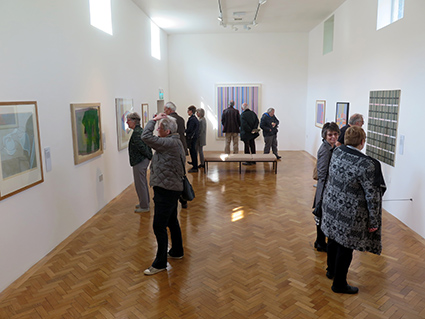Amanda Geitner, the exhibition's curator, says,"This exhibition brings together six artists whose work is distinguished by a willingness to experiment with their materials, playing with substance and form, sometimes risking failure to achieve success. The desire to take risks is a defining feature of creativity. Sometimes these risks are grave, pushing materials and processes to their limits and hoping that the outcome will not end in complete destruction. At other times, these risks are much more playful, signalling a willingness to try something completely new and experiment with it, allowing the work to evolve and arrive at destination that was not foreseen at the start.
Working with paint, paper, canvas, board, gesso, foam, bronze, steel, concrete and clay, this diverse group of artists risk mess, imperfection, breakage, cracking and collapse. Sometimes the risks are discrete and the results immaculate, at other times the experiments remain visible on the work. In them all I saw extraordinary presence and energy – work that is sometimes uneasy in its attraction, but always captivating".
A personal response to the exhibition by Susan Bonvin
This exhibition featured the work of six UK artists. It was shown in the main gallery on floor 2 with a smaller selection in the café/foyer.
I enjoyed the multi-layers of meaning in Susan Gunn’s delicately contained paintings in cracked gesso. The risk taking was clear, as the cracking must rely to some extent on processes which she cannot fully control. On the one hand, the pieces were organic, celebrating chance through experimenting with the material effects of process. However, on the other hand, the pieces were exquisite in their exacting craftsmanship; as if the discipline of a watchmaker could gracefully combine with serendipity.
Lee Grandjean provided a complete contrast to Susan Gunn’s approach. Colour and form were expressive and suggested places, objects and figures related to issues of the contemporary world, such as the suffering and the horrors of war. All his objects were loaded with a sense of disquiet. His piece “From the Fields” was a mix of humour and nightmare; was this commanding sculpture/object a funny scarecrow? Or a hobo in a sombrero – maybe propped up - or did the prop represent a torrent of pee straight onto the gallery floor? Or was the human-size object a cockerel after all?.... the two “Worldy Goods” trolley sculptures were particularly evocative. His large painting of bombed out buildings (hung directly to the wall without stretchers) had raw and foreboding associations. This painting provided a good example of artistic risk. In complete contrast to the flat illusion of the doors and windows, Grandjean had fixed a little shelf, almost like a balcony with a strange sculpture attached. The mix in medium, colour and handling should have clashed, but actually provided an exciting tension. It appeared that for Grandjean, intuitive artistic risks were integral to his approach.
I enjoyed looking at Elizabeth Merriman’s work. It was interesting to see one of her still lives hung between two of Susan Gunn’s. This was a painting of a vase of flowers divided into two halves horizontally. The lower portion was a pencil drawing of the vase. The upper portion was painted with highly coloured flowers in a closely worked manner. This was a pre-determined risk and I first thought it rather awkward. However, I went back to look again and I thought it worked well. The other still lives took similar risks, for example by switching from heavy blocks of colour to a delicate tracery.
It was clear that Nessie Stonebridge, Craig Hudson and Chris Taylor also took risks as part of their practice. Nessie Stonebridge painted scenes from nature with swirls and spirals that led into the centre of her square canvases. Risks were taken with the presentation of these with wooden extensions that sometimes reached down to the floor or across the wall. These seemed rather separate from the paintings. The curved fan additions to her work downstairs did relate to the painted swirls on the canvases a little better, but still remained attached items. Craig Hudson’s work was mainly based on the figure, but there were two works based partially on re-used plaster fragments and other elements. The smaller of these placed adjacent to Susan Gunn’s work had an air of mystery about its content and references. Chris Taylor experimented with the surface of his pots. The images applied were distressed, as though effected by time and layers partially overlapping. This led to complex and intriguing references.
Overall, I thoroughly enjoyed the exhibition. The balance between an over-arching link and contrasting approaches was just right. The format of the catalogue, which allowed the viewer to pull out any of the separate inserts to read alongside the artists’ exhibits was easy to handle and very helpful. The hanging and positioning of the work in relation to the architectural space and its interruptions was excellent, and added to the enjoyment of the exhibition. This also applied to the lighting, which naturally slightly stressed the two ends of the gallery on the day of my visit.









